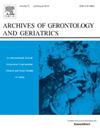The diagnostic performance of phase angle for sarcopenia among older adults: A systematic review and diagnostic meta-analysis
IF 3.5
3区 医学
Q2 GERIATRICS & GERONTOLOGY
引用次数: 0
Abstract
Objective
Phase angle is a promising tool for diagnosing sarcopenia. This study aimed to summarize its diagnostic performance by performing a systematic review and meta-analysis.
Methods
We conducted a systematic search of PubMed, Web of Science, Embase, and Scopus. The Quality Assessment of Diagnostic Accuracy Studies, Version 2, was used to evaluate the quality of the studies. A bivariate random effects model was employed for data synthesis, and diagnostic performance was reported in terms of pooled sensitivity, specificity, and the area under the summary receiver operating characteristic curve (AUC). Additionally, meta-regression, subgroup analyses, and sensitivity analyses were performed.
Results
A total of 15 studies were included in this meta-analysis, involving 4,063 participants. The overall risk of bias in the included studies was high. The meta-analysis revealed that the pooled sensitivity and specificity across all studies were 0.74 [95 % confidence interval (CI): 0.71–0.78] and 0.75 (95 % CI: 0.70–0.79), respectively, with an AUC of 0.79 (95 % CI: 0.76–0.83). Meta-regression indicated that study design, country, population, sex-specificity, and age may influence the diagnostic performance of phase angle. The optimal diagnostic performance was observed in the cut-off interval of 4.20 to 4.50°.
Conclusion
The phase angle demonstrated moderate diagnostic performance for sarcopenia, and the possible cut-off interval is 4.20 to 4.50 °. However, large-scale, multicenter prospective studies are necessary to assess its clinical applicability at specific cut-off values.
相位角对老年人肌肉减少症的诊断效果:一项系统综述和诊断荟萃分析。
目的:相位角是诊断肌肉疏松症的有效工具。本研究旨在通过系统综述和荟萃分析总结其诊断性能:我们对 PubMed、Web of Science、Embase 和 Scopus 进行了系统检索。方法:我们对 PubM、Web Science、Embase 和 Scopus 进行了系统检索,并使用诊断准确性研究质量评估(第 2 版)对研究质量进行评估。数据综合采用了双变量随机效应模型,诊断结果以集合灵敏度、特异性和接收者工作特征曲线下面积(AUC)进行报告。此外,还进行了元回归、亚组分析和敏感性分析:本荟萃分析共纳入了 15 项研究,涉及 4063 名参与者。纳入研究的总体偏倚风险较高。荟萃分析显示,所有研究的集合灵敏度和特异性分别为 0.74 [95 % 置信区间 (CI):0.71-0.78] 和 0.75 (95 % CI:0.70-0.79),AUC 为 0.79 (95 % CI:0.76-0.83)。元回归表明,研究设计、国家、人群、性别特异性和年龄可能会影响相位角的诊断性能。在 4.20 至 4.50°的截断区间内观察到了最佳诊断效果:相位角对肌肉疏松症的诊断效果一般,可能的临界值区间为 4.20 至 4.50°。然而,有必要进行大规模、多中心的前瞻性研究,以评估其在特定临界值下的临床适用性。
本文章由计算机程序翻译,如有差异,请以英文原文为准。
求助全文
约1分钟内获得全文
求助全文
来源期刊
CiteScore
7.30
自引率
5.00%
发文量
198
审稿时长
16 days
期刊介绍:
Archives of Gerontology and Geriatrics provides a medium for the publication of papers from the fields of experimental gerontology and clinical and social geriatrics. The principal aim of the journal is to facilitate the exchange of information between specialists in these three fields of gerontological research. Experimental papers dealing with the basic mechanisms of aging at molecular, cellular, tissue or organ levels will be published.
Clinical papers will be accepted if they provide sufficiently new information or are of fundamental importance for the knowledge of human aging. Purely descriptive clinical papers will be accepted only if the results permit further interpretation. Papers dealing with anti-aging pharmacological preparations in humans are welcome. Papers on the social aspects of geriatrics will be accepted if they are of general interest regarding the epidemiology of aging and the efficiency and working methods of the social organizations for the health care of the elderly.

 求助内容:
求助内容: 应助结果提醒方式:
应助结果提醒方式:


